
EPA Prepares for Their Largest River Cleanup in History
The EPA has proposed a plan to remove more than 4 million cubic yards of contaminated sediment from 8 miles of the Passaic River in New Jersey. This will mark the largest river cleanup in EPA history.
Sediment in the Passaic River is severely contaminated with pesticides, heavy metals, dioxin, polychlorinated biphenyls (PCBs), and other harmful contaminants from the industrial activity the river has experienced for more than a century. The majority of the contaminants are located in the lower eight miles of the river.
The EPA is planning to conduct bank-to-back dredging, which will then be followed by capping of the river bottom. In order to create their cleanup proposal, the EPA has conducted a seven-year study to help determine the best ways to remedy the contaminated area of the river.
“High concentrations of dioxin, PCBs and other contaminants in the lower eight miles of the Passaic River are a serious threat to the people who eat fish and crabs from this river,” said Judith A. Enck, EPA regional administrator. “The EPA’s proposed cleanup plan will result in a cleaner river that protects people’s health and increases the productive use of one of New Jersey’s most important natural resources and creates jobs during the cleanup. Doing less is not good enough for this river or the people who live along it.
To view the EPA’s plan for the Passaic River, please click here.